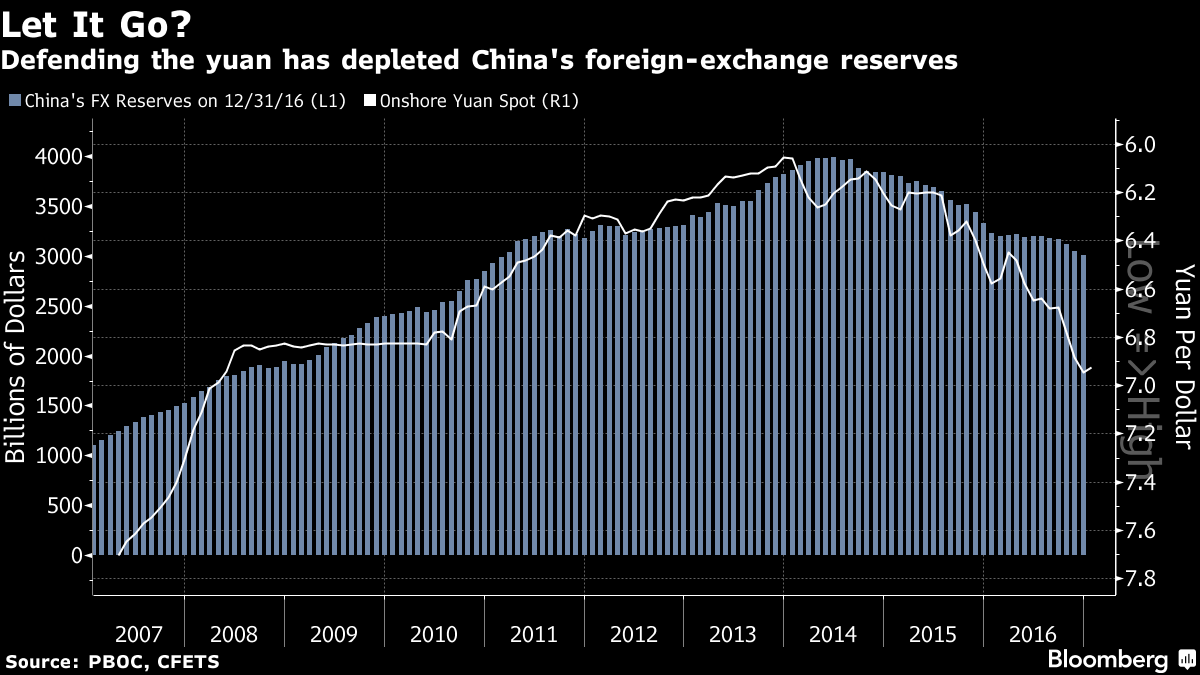A Free-Floating Yuan Is Looking a Bit More Likely

As China’s yuan swings back into the global spotlight, it might seem like an odd time for authorities in Beijing to loosen their grip on the tightly-managed currency.
Yet for a growing number of analysts and investors, the prospect of a freely floating yuan -- a Chinese exchange rate wholly determined by market forces -- is no longer a distant possibility. Advocates include a government-backed researcher and a former central bank adviser, while bond-market powerhouse Pacific Investment Management Co. says the chances of a free float are rising.
The risks of unshackling China’s currency are hard to ignore. It would almost certainly lead to a knee-jerk tumble, exacerbating capital outflows and sending shockwaves through global markets. Investors around the world took notice of the yuan’s elevated volatility last week, even as it paled in comparison to everyday swings in many developing-nation peers.
Free-float proponents say the long-term benefits for China outweigh the costs. A quick transition to a market-determined exchange rate would allow the country to preserve its foreign-currency reserves, re-assert control over domestic monetary policy and combat criticism from U.S. President-elect Donald Trump that Communist Party apparatchiks are manipulating the currency.
“At the end of the day, what you have to accept is the value of the currency as it is right now isn’t appropriate,” said Luke Spajic, the head of emerging Asia portfolio management at Pimco, which oversees about $1.55 trillion and is calling for a mid- to high-single digit yuan depreciation over the next year. “Things need to change.”
The People’s Bank of China didn’t reply to a faxed request for comment.
Under the country’s current rules, the yuan can move a maximum 2 percent from the central bank’s daily fixing, though the spot rate has seldom come close to the band’s edges since an August 2015 change designed to create a more market-based system. China is widely assumed to influence the exchange rate through government intervention; an $833 billion slide in currency reserves over the past two years suggests authorities are propping up the yuan via dollar sales.
Just last week, a short squeeze in the offshore market for yuan in Hong Kong was attributed by some analysts to government meddling. After touching a record low in the city on Jan. 2, the Chinese currency rallied about 1.9 percent to 6.8598 per dollar through 6:12 p.m. Hong Kong time on Thursday.
The nation’s existing approach allows policy makers to manage the pace of yuan depreciation, preventing abrupt market swings that could destabilize the financial system. With authorities focused on economic stability ahead of a key leadership reshuffle this year, it’s easy to see why they’d prefer an exchange-rate system that gives them a degree of control.
Intervention has its costs, though. While last week’s surge in interbank lending rates shook out bearish speculators in Hong Kong, it also set back China’s efforts to make the yuan an international currency. The central bank’s focus on managing the exchange rate and stemming capital outflows also reduces its leeway to adjust domestic borrowing costs to suit the domestic economy, a trade-off known as the “impossible trinity.”
“If you don’t release the depreciation pressure, China’s monetary policy will be in a tough position,” said Zhu Baoliang, Beijing-based chief economist at the State Information Center, which is backed by China’s government planning body, the National Development and Reform Commission. “Allowing yuan depreciation can reduce domestic risks and interrupt the transmission of global risks.”
For all the imperfections of China’s current system, Mizuho Securities Asia Ltd. economist Shen Jianguang says now is not the time to liberalize the exchange rate. With the U.S. Federal Reserve projected to raise borrowing costs further this year, a free-floating yuan would tumble against the dollar and fuel “massive” capital outflows, Shen said. Rather than applaud China’s adoption of a market-based rate, the Trump administration could deride the move as harmful to U.S. interests, Shen said.
“If they’re going to liberalize the exchange rate, there’s only one way to go: the renminbi would depreciate,” he said, using another name for the Chinese currency. “The market would panic as we witnessed in 2015.”
Consensus analyst forecasts and positioning in derivatives markets suggest most China watchers don’t foresee a major shift in currency policy anytime soon. The median estimate in a Bloomberg survey calls for the yuan to drop 3.5 percent versus the dollar by year-end, while options are pricing in just a 30 percent chance the currency will weaken 10 percent over the same period.
China is still better off letting the yuan fall to its natural level than burning reserves to slow its retreat, said Yu Yongding, former academic member of the PBOC’s monetary policy committee. He and Zhu both argue that China doesn’t have to worry about a sharp fall in the currency because the nation’s reserves and trade surplus are still large and inflation is low.
“Intervention can limit volatility, but it can’t change the trend,” Yu said. “Ultimately, you’ll have to give up anyway.”
It’s a view shared by BNP Paribas Investment Partners and London-based think tank Chatham House. Paola Subacchi, Chatham’s research director of international economics, says even if Chinese policy makers don’t pursue a free float, they could widen the yuan’s trading band to signal a greater role for market forces.
“It would be perfectly legitimate for Chinese policy makers to turn around and say: ‘If you complain that we are manipulating the exchange rate, then we’ll widen the band and let the market decide,”’ said Colin Harte, a fund manager in London at BNP Paribas Investment Partners, which oversees about 560 billion euros ($591 billion).
Courtesy of Bloomberg
